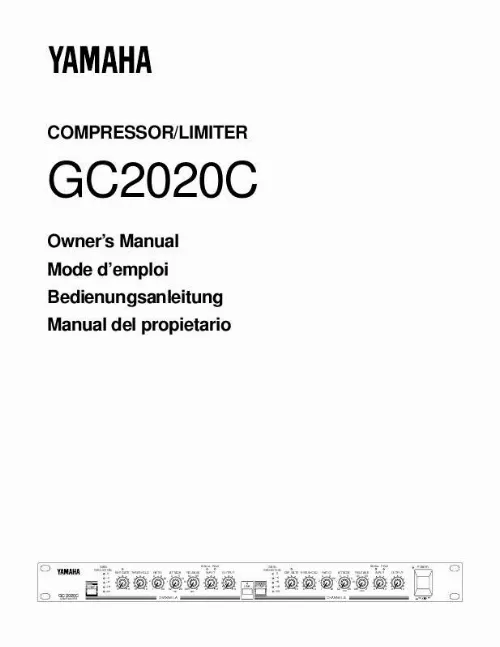Notice YAMAHA GC2020C
Liens commerciaux


Extrait du mode d'emploi YAMAHA GC2020C
Les instructions détaillées pour l'utilisation figurent dans le Guide de l'utilisateur.
All signals below the set threshold level are passed as received at the INPUT jacks, with no compression or limiting applied. Signals going above the set threshold level, however, are compressed or limited according to the settings of the RATIO, ATTACK, and RELEASE controls. Attack Time The Attack Time determines how long it takes--in milliseconds--before the full amount of compression is applied once the threshold level is exceeded. The ATTACK time range is from 0. 2 milliseconds, a very fast attack, to a relatively slow 20 milliseconds. The attack time setting depends largely on the type of signal being processed and the type of effect desired. A very fast attack, for example, will compress the initial attack of an instrumental note making it sound "dull". High levels of compression are sometimes used on electric guitar, for example, to give the sound greater sustain. In this application it is often better to set a longer attack time so that the crisp attack of the guitar note "gets through" before full compression is applied. Set the attack time to accommodate the natural attack of the sound being processed. ATTACK TIME Control Function Ratio This is the amount of compression applied to signals that exceed the threshold level set by the THRESHOLD control. The compression ratio is expressed in terms of the amount of change in the level of the input signal in relation to the corresponding amount of change in the level of the output signal. A high ratio means a lot of compression. A compression ratio of 1:1, therefore, implies no compression--a change of 1 in the level of the input signal produces a corresponding change of 1 in the level of the output signal. A compression ratio of 2:1, however, means that for a given change in the level of the input signal (2) the level of the output signal will only change half as much (1). The extreme would be a compression ratio of :1 (infinity to one), meaning that no matter how much the input signal level changes the output signal level will remain constant. [...] This ratio describes how much the signal appearing at the output of the compressor changes in relation to a given change in the level of the original signal applied to the input. If no compression is applied and the input signal doubles in level, then the output signal will also double in level, precisely following the change in the input signal. This corresponds to a compression ratio of 1:1 (read "one to one") --a change of 1 at the input produces a change of 1 at the output--i. no compression. Now if we apply some compression, a smaller change in the level of the output signal will be observed for the same change in input signal level. A compression ratio of 2:1, for example, would mean that the level of the output signal will change only half as much as the input signal. Expressed in decibels, a compression ratio of 20:1 would mean that a 20 dB change in the level of the input signal would result in only a 1 dB change in the level of the output signal. Thus, a compressor is able to reduce the dynamic range of an audio signal by any desired amount. See Figure 1. (dB) 1:1 NO COMPRESSION Limiter Limiting is basically extreme compression that is set to affect only signals above a certain level. This is particularly useful for limiting only peaks that exceed the handling capacity of the related equipment, without affecting the rest of the signal. See Figure 2. (dB) Output Signal Level Limiting Threshold 0 Input Signal Level LIMITING (dB) Figure 2 Suppose we wanted to limit the peak levels in a program to a maximum of 0 dBm, in order to prevent saturation and distortion in a tape recorder. First we would set the "threshold" level to 0 dB--the threshold level is the input signal level at which the limiter will begin to operate. Then we would set the maximum (or near maximum) compression available--:1 (infinity compression). Infinity compression means that absolutely no change in the output level will occur no matter how much the input signal changes. As a result, all signal content below the threshold level (0 dB) will be passed exactly as it appears at the limiters input. Signals exceeding the threshold level, however, will be output at the threshold level and will rise no higher. In this case no signal exceeding 0 dB will appear at the limiter's output. The actual audio signal remains untouched, just its average (r. ) level is kept within the defined limits. [...]..
Téléchargez votre notice ! Téléchargement gratuit et sans inscription de tous types de documents pour mieux utiliser votre YAMAHA GC2020C : mode d'emploi, notice d'utilisation, manuel d'instruction. Cette notice a été ajoutée le Samedi 10 Octobre 2008.
Vous pouvez télécharger les notices suivantes connexes à ce produit :
Vos avis sur le YAMAHA GC2020C
 Très bon produit, excellent produit. Excellent rapport qualité prix, bon materiel.
Très bon produit, excellent produit. Excellent rapport qualité prix, bon materiel.



